The Charming Strangeness of Street Names
How foreign street names keep us feeling not quite at home
A couple of years ago, I lived for a time on a street called Travessa da Conceição da Glória, which translates literally as “Cross-street of the Conception of Glory”. I find that names like this help prevent me from ever feeling blasé about living here in Europe, serving as a continual reminder that we’re not in Kansas anymore, Toto.
I am fascinated by the ways in which communities decide to name their thoroughfares. There are many different systems for doing so, some of which feel comfortably familiar to me as someone who grew up in North America, and some of which never stop feeling foreign. I’d like to take you on a little excursion through the sometimes lovely and sometimes bizarre methods of choosing street names that I have encountered over the years.
Essentially, there seem to be about six approaches to picking street names:
naming them with numbers or letters
naming them after people
naming them after things
naming them after places
naming them after concepts or events
naming them descriptively
By far the most boring of these is using numbers or letters. Everyone who has been to Manhattan knows that locations such as “East Forty-Second and Fifth” do the job but fail to excite the imagination (though what you find there might do so). In Lisbon, there is a neighborhood not far from mine, built as a project around 1940, in which the streets are called “Street 1” through “Street 30” (Rua 1, Rua 2, Rua 3, etc.), although streets 1 and 3 seem to have been subsequently renamed Rua dos Marcos and Rua José Luis Garcia Rodrigues—go figure. Such numbered systems generally work well—though I used to live in Ann Arbor on Fifth Street, not Fifth Avenue, thank you very much mister delivery driver—but are, frankly, pretty darned boring. Also, I find that streets and routes with numbers can be hard to remember.
It is more fun to name streets after people. There are three levels of this. At one end is naming the street after the first person to live there (something that happens quite frequently in rural America, as in “Wayne Road”). At the other end is naming the street after someone famous that virtually everyone will have heard of, as in “Martin Luther King Junior Boulevard”, which can then be called just “MLK Jr Boulevard”, or even “MLK”.
In the middle is a fascinating option, which is to name a street after a local individual who would otherwise probably be forgotten. In Lisbon, when a street is named after a person, the sign will frequently include an explanation of what the person was famous for: painter, historian, professor, industrialist, etc. I fantasize about one day having a street named after me in Lisbon, with the inscription, Rua Gregory Garretson, Escritor e Amigo de Portugal. But of course to get that, I would have to be dead, so maybe I shouldn’t wish for it.
In Southern European cities, naming streets after people is very common. In Portugal, this combines uneasily with the fact that there is a relatively small number of names in common use, both given names and surnames. This leads to situations such as the following: In the neighborhood where I lived until recently, there is a street called Rua Pereira e Sousa and a street called Rua Almeida e Sousa, which I could never keep straight. There is also a street called Rua Saraiva de Carvalho and a street called Rua Silva Carvalho. You could actually live on the corner of Saraiva de Carvalho and Silva Carvalho. If you did, you could get pretty good bagels—I like the place there—which might be a good consolation after all of the linguistic confusion suffered.
Naming streets after things is generally more typical of Northern Europe, and certainly of the United States. When a development is planned, the streets are often named in sets according to a theme. I have a friend in Sweden who lives in a neighborhood where the streets are called Bergvägen, Blåbärsvägen, Lingonvägen, Koltrastvägen, Ekorrvägen, Mårdvägen, etc.—that is, “Mountain Street”, “Blueberry Street”, “Lingonberry Street”, “Blackbird Street”, “Squirrel Street”, “Pine Marten Street”, etc. Such names usually evoke pleasant associations, though it’s hard not to perceive a certain cynical cold-bloodedness when a developer chops down a forest and puts in 300 houses under the name “Peaceful Forest Hills” or suchlike, naming all of the streets after the sorts of trees that used to be there.
Speaking of Sweden, there is a fascinating practice there related to street names. For the Swedes, who are truly master planners, it is not enough to name the streets—they also name the blocks. This blew my mind when I first learned about it. As an American, I always thought of city blocks as the stuff between streets. But in Sweden, they think of streets as the space between blocks, and give each contiguous city block a name. These are usually thematic as well. The neighborhood where I used to live in Stockholm had once been farmland (see above), and when it was cleared and built up, each block of houses (kvarter) was given the name of a vegetable: Moroten, Vitbetan, Rovan, Gurkan, etc.—that is, “The Carrot”, “The White Beet”, “The Turnip”, “The Cucumber”, etc. It made me childishly happy that the buildings in “The Carrot” were painted orange, though at the same time, it didn’t feel terribly dignified to say, “Yes, I live in The Turnip.”
Everywhere I have ever lived, there have been streets named after places. It thrills me that in many European cities, major thoroughfares are often named after the town that they lead toward. For example, in Berlin, Potsdamer Straße actually leads in the direction of Potsdam, and Oranienburger Straße leads (at least theoretically) in the direction of Oranienburg. These roads were originally given these names for the benefit of people traveling without maps—which was nearly everyone.
Of course, sometimes streets are named after foreign countries. In countries such as Portugal that had overseas colonies, this has bittersweet associations. Avenida do Brasil, Rua de Angola, Rua de Cabo Verde, Rua de Timor, etc. are reminders of the many places that were once plundered by the Portuguese. That said, there is a big, fat thoroughfare in Lisbon called Avenida dos Estados Unidos da América, and as far as I know, the USA was never a Portuguese colony (if anything, the reverse relationship is starting to hold).
Now we are coming to the things that I find most interesting about street names in Europe. Many of them are named after concepts, such as liberty, independence, and progress—In Barcelona, you can actually stand at the corner of Liberty and Fraternity—which segues nicely to grand streets with names of political entities such as Avenida da República (in Lisbon) or Gran Via de les Corts Catalanes (in Barcelona). You also get nice abstractly named places like Piazza del Popolo (“Square of the People”) in Rome or Medborgarplatsen (“Square of the Citizens”) in Stockholm.
But for me, the next category is the key one. In Southern Europe in particular, there is a tradition of naming streets after political events. The difficulty that this presents, however, is how to refer to an event without letting the name get too long and unwieldy. There are a couple of solutions to this problem. One is to refer to a set of people: In Lisbon, we have the Praça dos Restauradores, which might sound like it is dedicated to people going out to dinner, but in fact pays tribute, with its rather grandiose obelisk, to those who waged war in 1640 to end a sixty-year period during which Portugal was ruled by the Spanish monarchy. I sometimes wonder how many people who walk through that square actually know this.
But there is another solution to the problem of how to refer to an event that I find totally fascinating, and utterly foreign. This is to refer to the date on which the event took place. The massive bridge that spans the Tejo river right at Lisbon, and looks for all the world like the Golden Gate Bridge, is called the Ponte 25 de Abril, which refers to the day in 1974 that saw the start of the revolution that ended more than forty years of dictatorship in Portugal. (As an aside, let us not forget that that was just fifty years ago; I think Portugal is doing pretty well for a country that spent half of the past century under a dictator.)
But of course you have to know what the date refers to. There is also a huge avenue running along the river in Lisbon called the Avenida 24 de Julho, referring to the 24th of July. But what happened on that day? Having researched it, I now know that it refers to an event in the Portuguese Civil War (or Liberal Wars), fought between 1828 and 1834 over which of two brothers was to inherit the throne. Specifically, on the 24th of July, 1833, the Duke of Terceira managed to capture Lisbon—on behalf of the winning side, obviously (we all know who writes the history books).1
Here is my question, though: Of the thousands of people who travel down the Avenida 24 de Julho every day, how many of them know where the name comes from? I have yet to find a Portuguese person who actually knows.
There is one last strategy for naming streets that I want to mention, and it is probably my favorite. This is naming them descriptively: after what people saw when they got there. In Lisbon, there is a Rua dos Sete Moinhos, or “Street of Seven Windmills”, where there were once, presumably, seven windmills. Today you can find at best the ruins of one windmill there, but the pleasant name lives on. This approach is especially common in Germanic countries; Sweden is filled with toponyms such as Storsjön, which just means “Big Lake”, and street names such as Lilla Strandvägen, which means “Little Street by the Shore”.
In Portugal, street names are frequently the result of a layering-on of descriptors. As a rule of thumb, the smaller the street, the longer the name. There is a spot in the Alfama where you can stand at the corner of the Largo do Outeirinho da Amendoeira and the Escadinhas do Arco da Dona Rosa—that is, the corner of the “Wide Place of the Hillock of the Almond Tree” and the “Little Steps of the Arch of Lady Rose”. Can it get more charming?
One of the layers of descriptors in Lisbon comes from references to local churches. Many of the oldest parts of the city here are named after the church that was the center of the parish, which tend to be named in the pattern of “Our Lady of X”. We have Graça, Glória, Misericórdia, Ajuda, etc.: Grace, Glory, Mercy, Assistance, etc. So if we go back to the street name with which we started, Travessa da Conceição da Glória, we can actually see how it is built up: Glória refers to the neighborhood, and Travessa, meaning cross-street, means that it is a street crossing the Rua da Conceição da Glória, which is true.

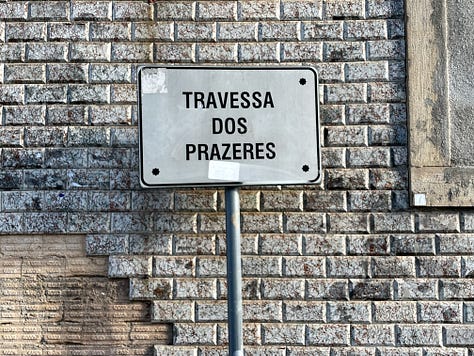
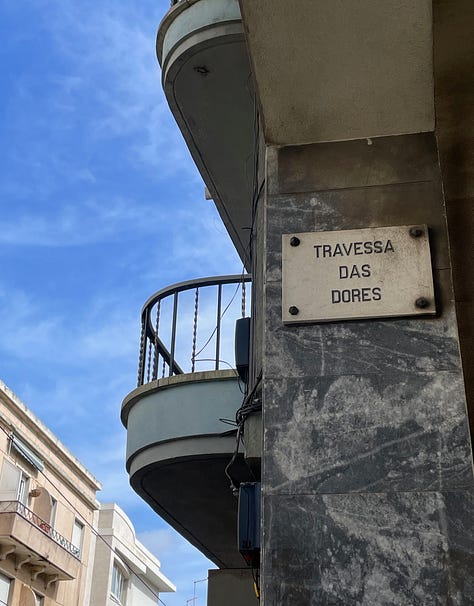
And then there is the tricky Portuguese word calçada, which refers to a path or street paved with the cobblestones that are so utterly characteristic of Portugal, and especially Lisbon. As such, calçada can refer to a sidewalk, but it can also refer to the lanes for vehicles (which might now be asphalted). Furthermore, calçada is used to refer to a long, steep street—of which there are many in Lisbon, given how hilly the city is. There are days when it feels like everything is a calçada.
I would like to end our tour on a light note. It’s always a pleasure when people show a sense of humor about place names. Close to where I live, there is a whole neighborhood in which each street is named after a Portuguese soldier who died in World War I. As a consequence, everyone in the area calls this neighborhood o Bairro dos Mortos, or “The Neighborhood of the Dead”. So it’s perfectly possible to say to someone, with a straight face, the Portuguese equivalent of the following: “I live right off the Street of the Fountain of the Marquis, in the Neighborhood of the Dead, between Good-Hour and the Steep Cobbled Street of Assistance.” It is things like this that keep me pleasantly conscious of living in a foreign country.

Terceira, which means “third”, is one of the islands of the Azores. Personally, were it possible, I would be the first to second a motion to send the Duke of Terceira up the Firth of Fourth to see James the Sixth.





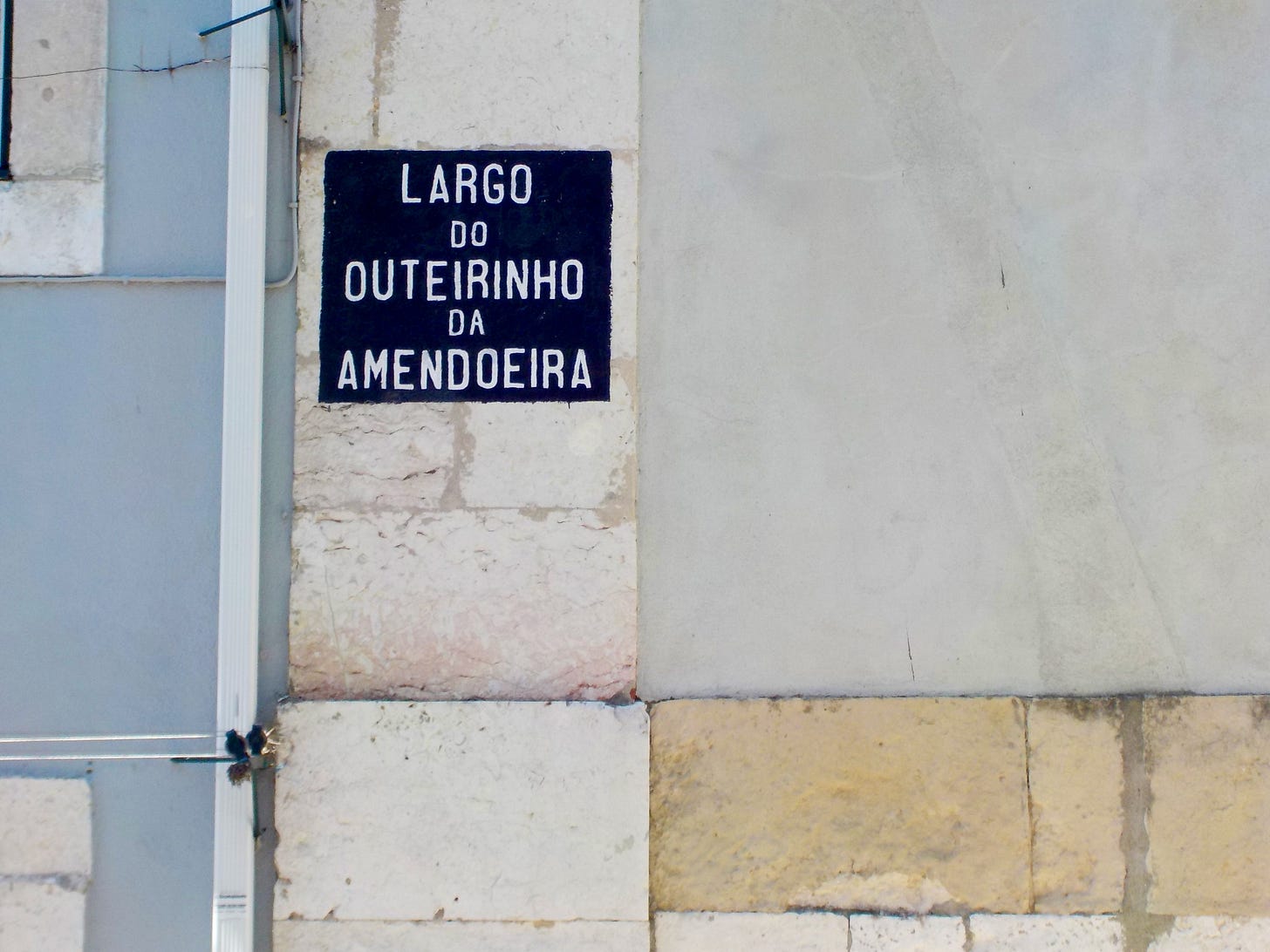
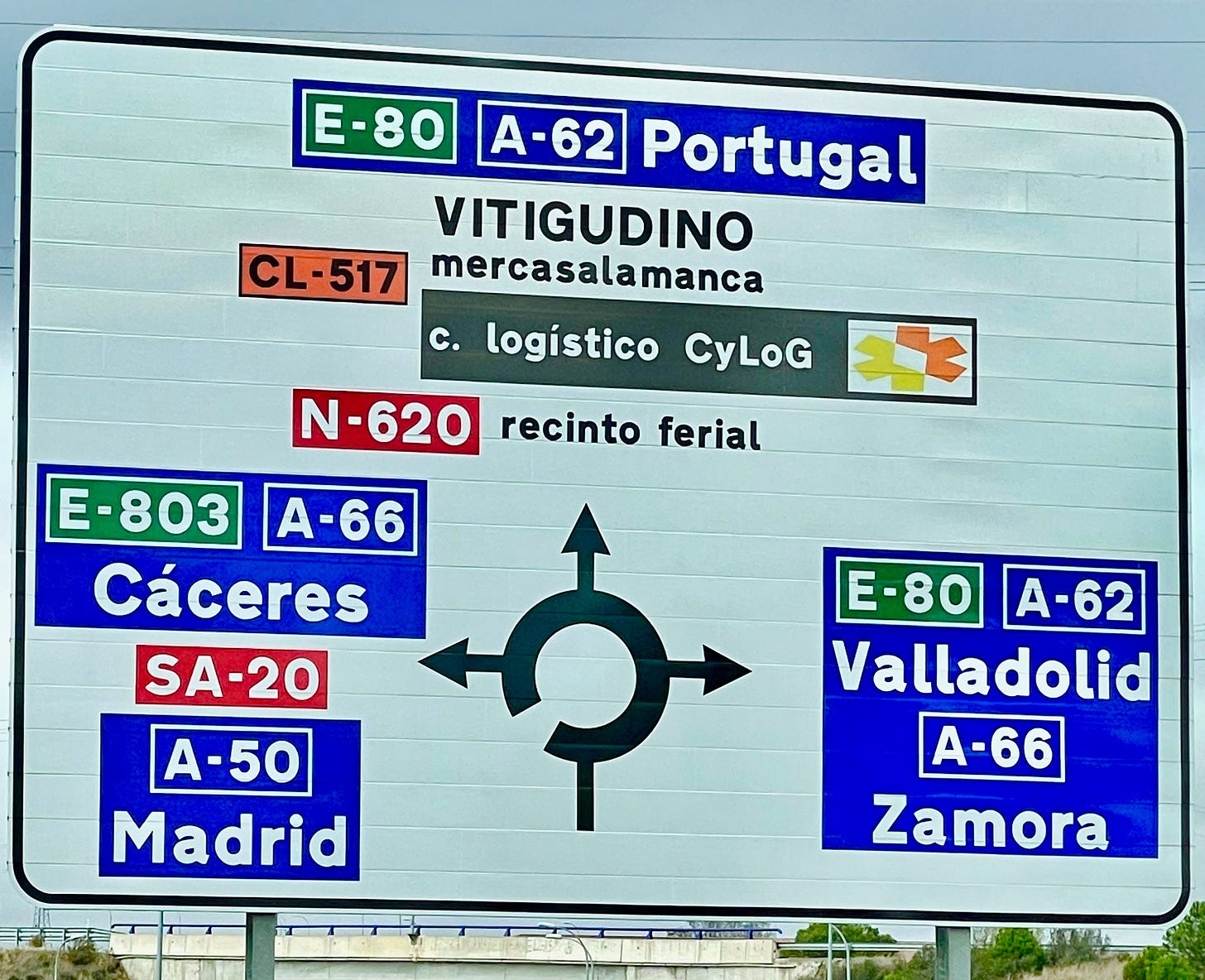

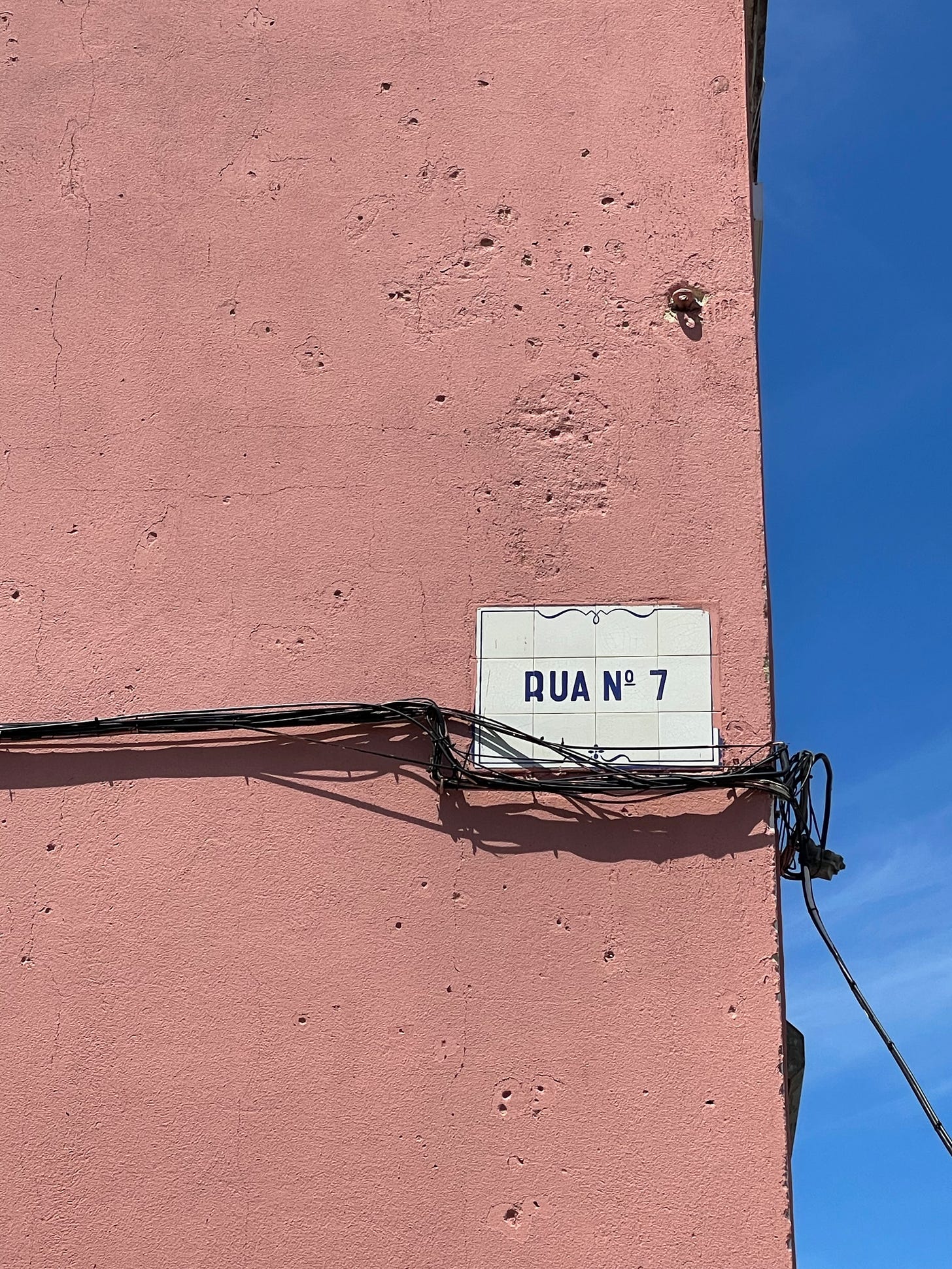
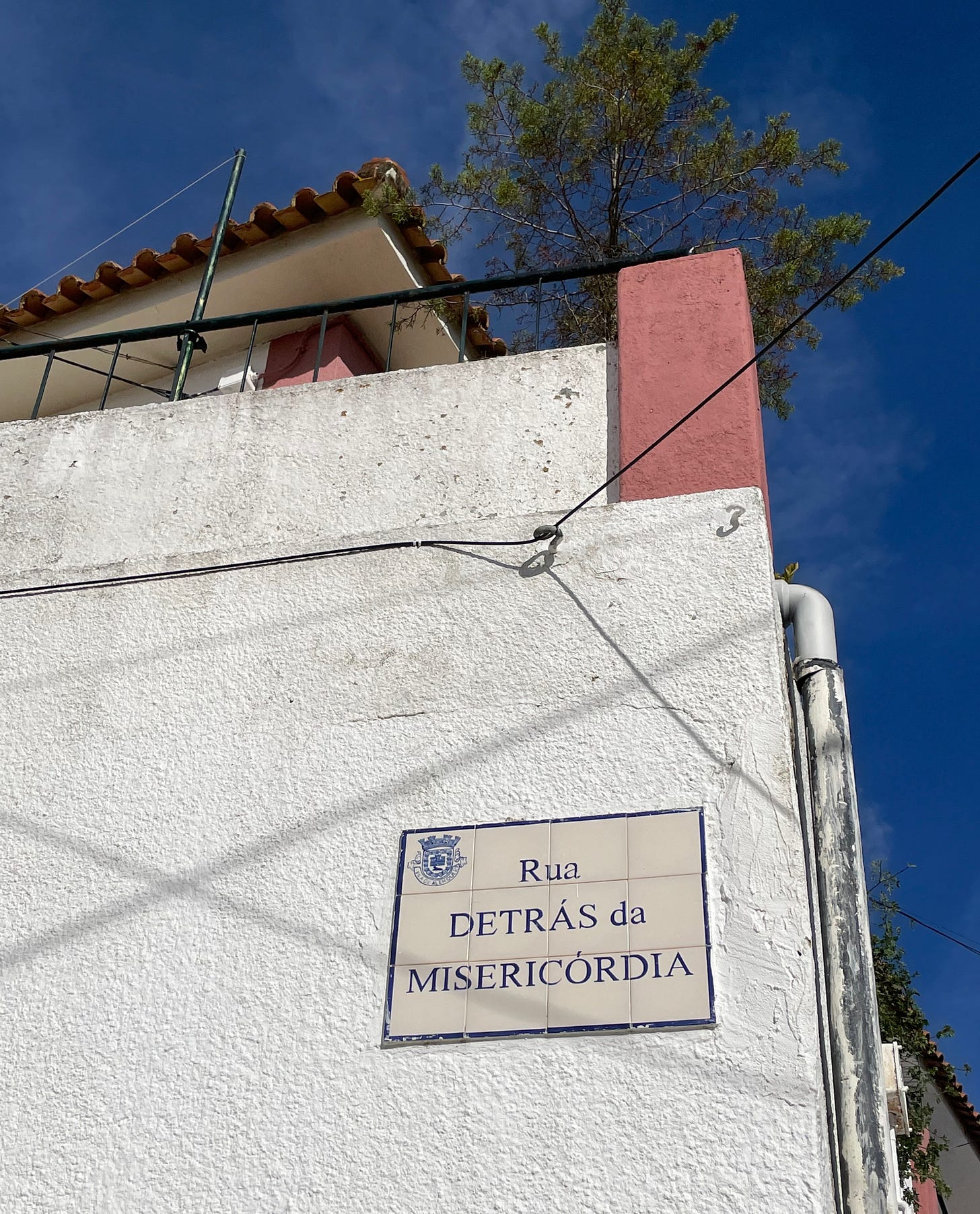
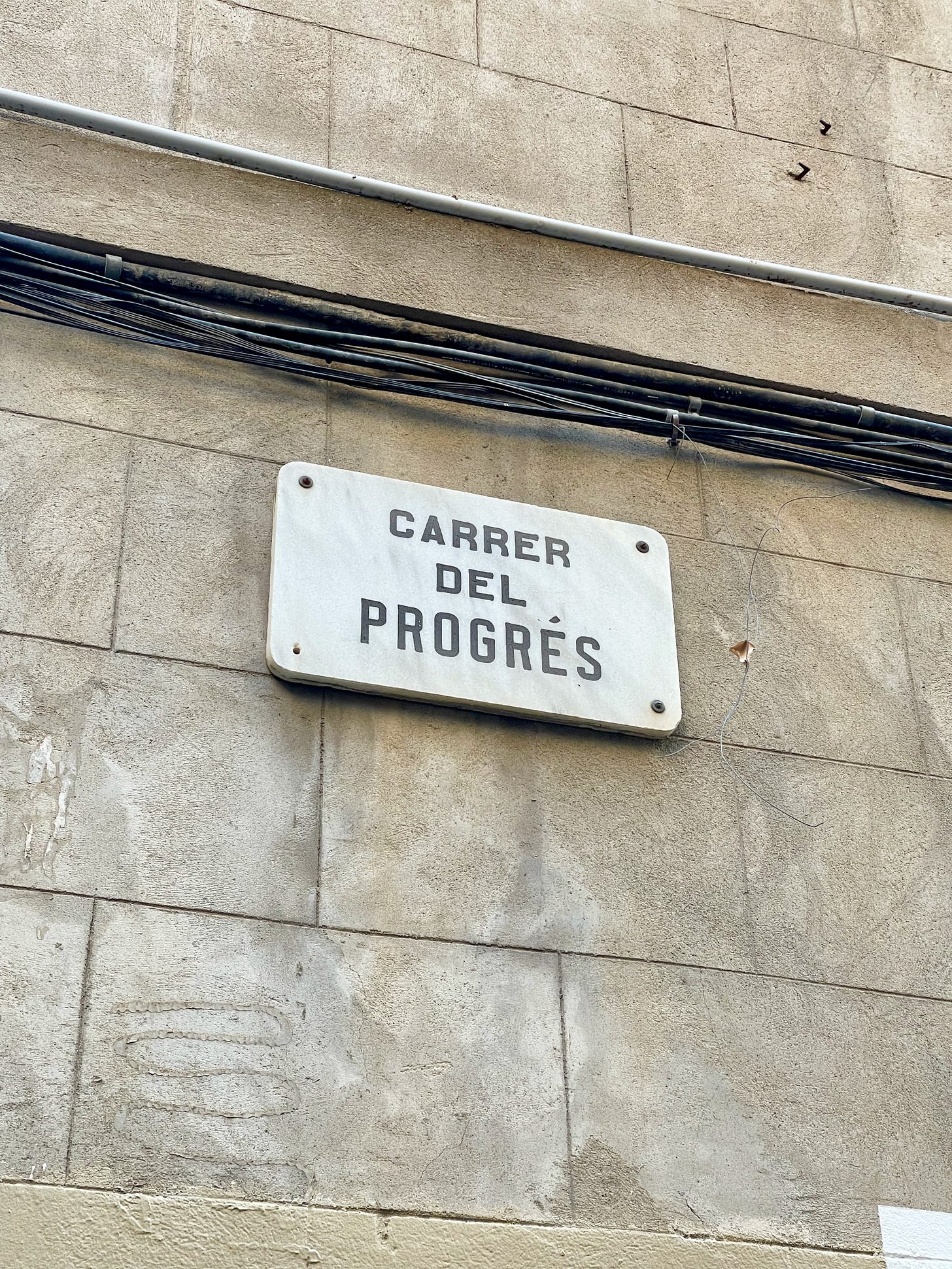
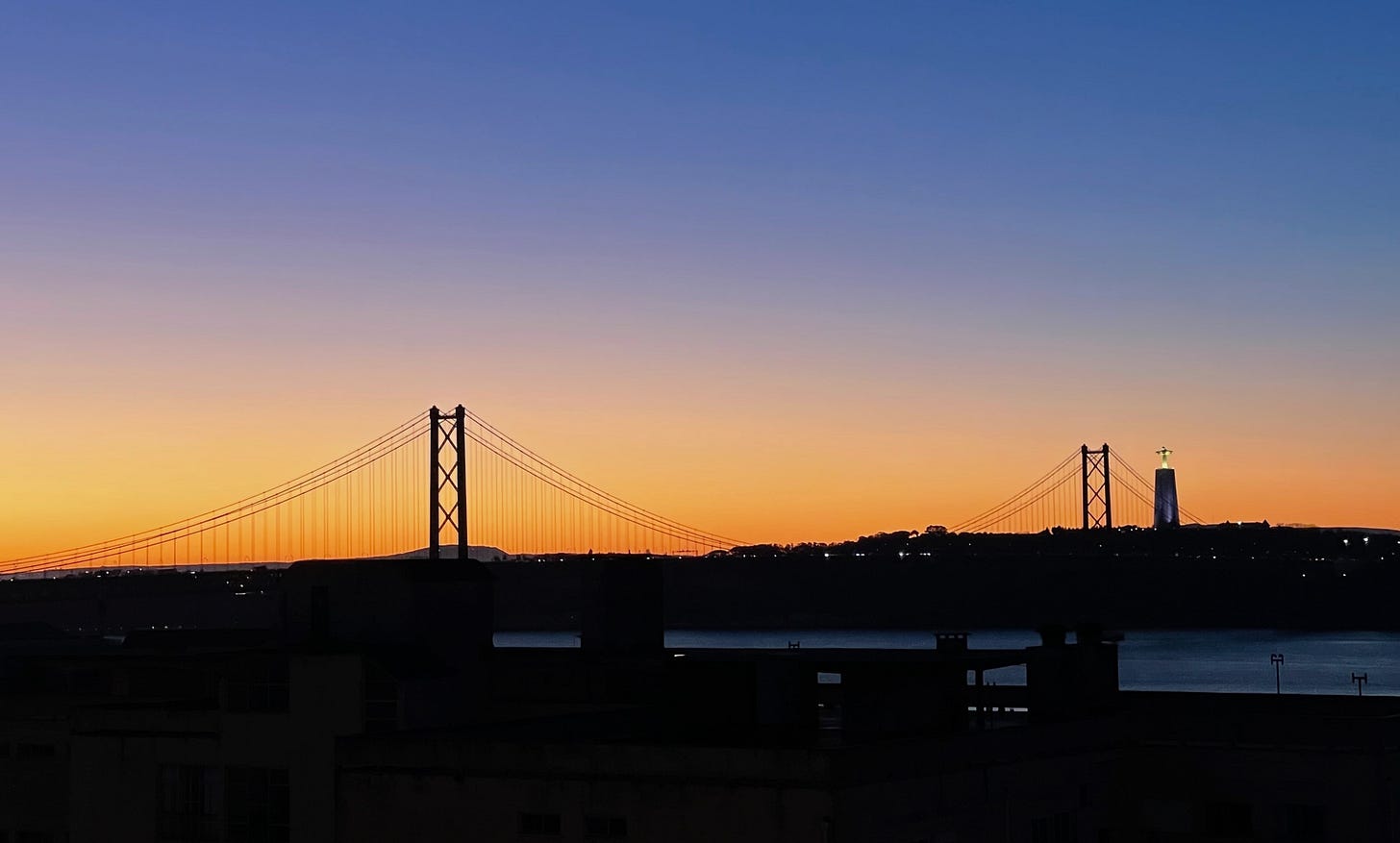
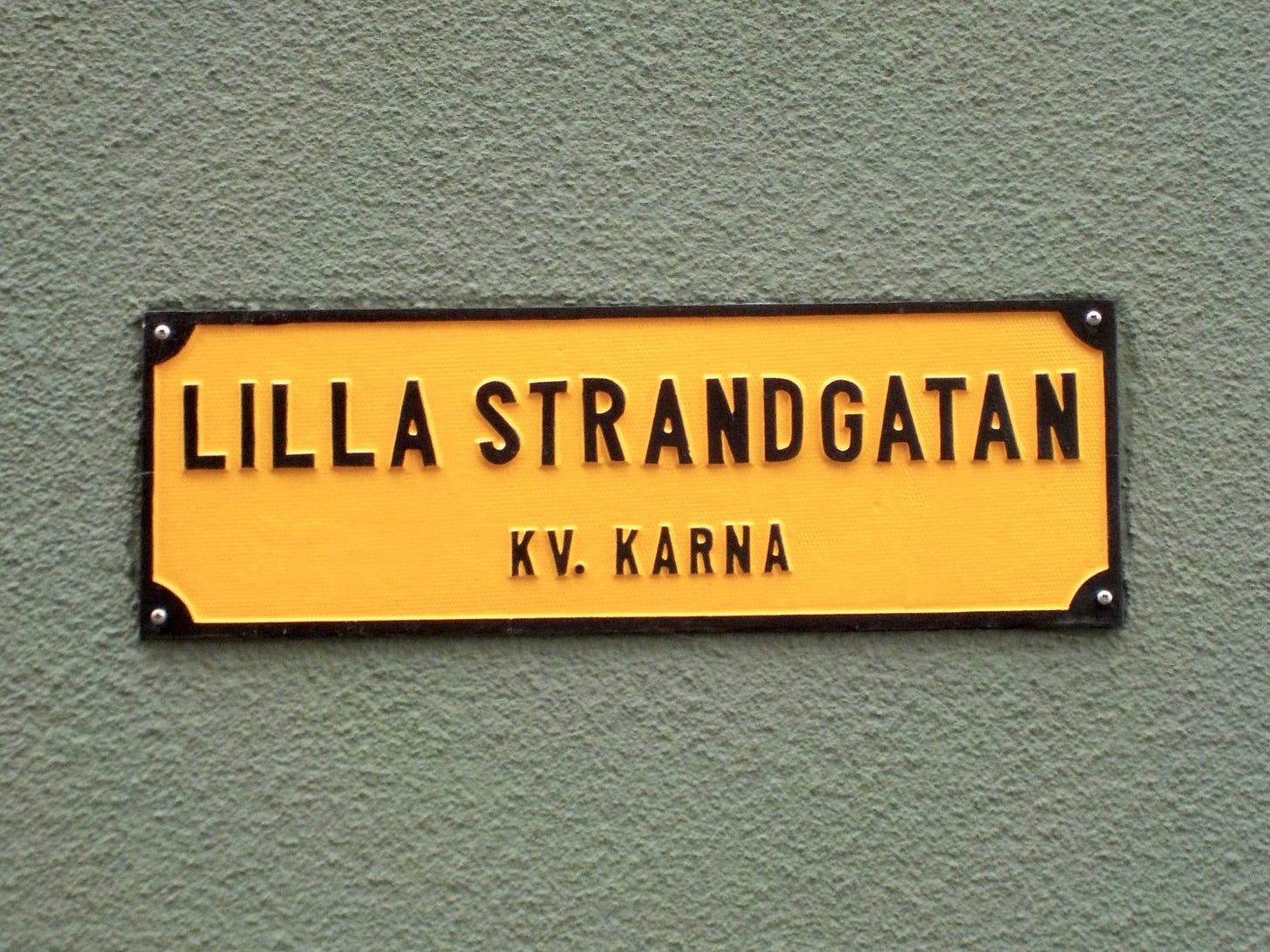
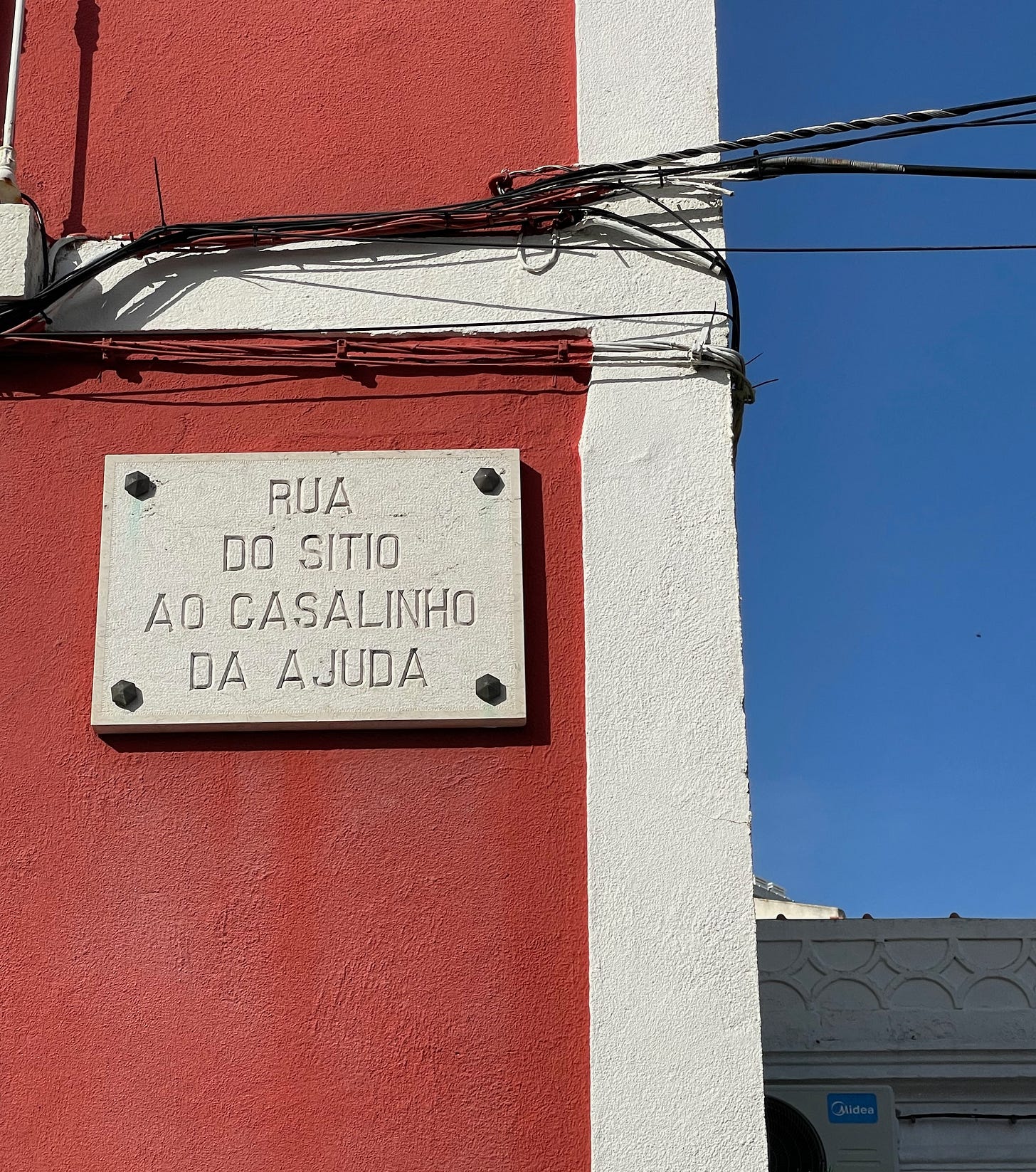
Once saw a street in the woods of central Maine…Amscray Lane. My husband and I still laugh about this. 😊
In my neighborhood there is a Rua Pires de Almeida and a Rua Ribeiro de Almeida, and I never know which is which, even though I've lived here for most of my life.
Downtown there is a street name that I particularly like: "Travessa dos Poetas de Calçada". Beautiful, isn't it? :-) Another good one is "Rua do Jogo da Bola" at Morro da Conceição. Old Rio.